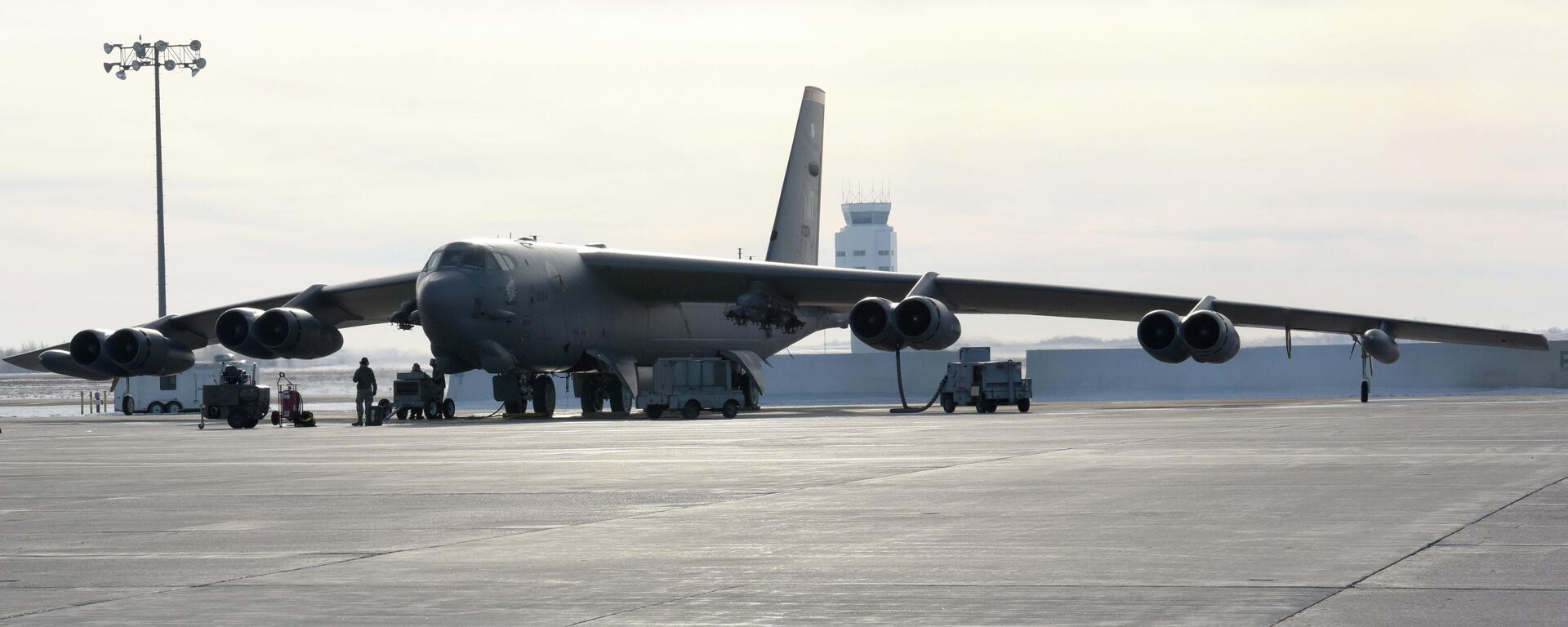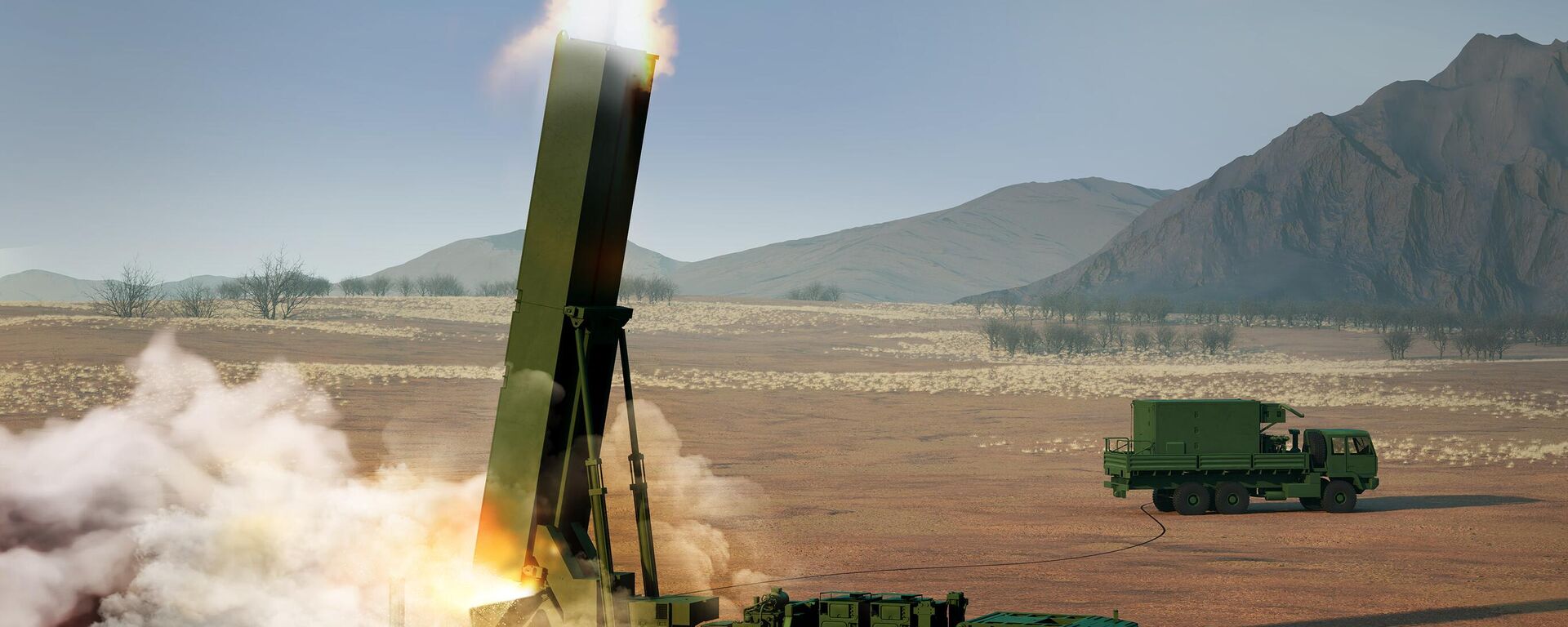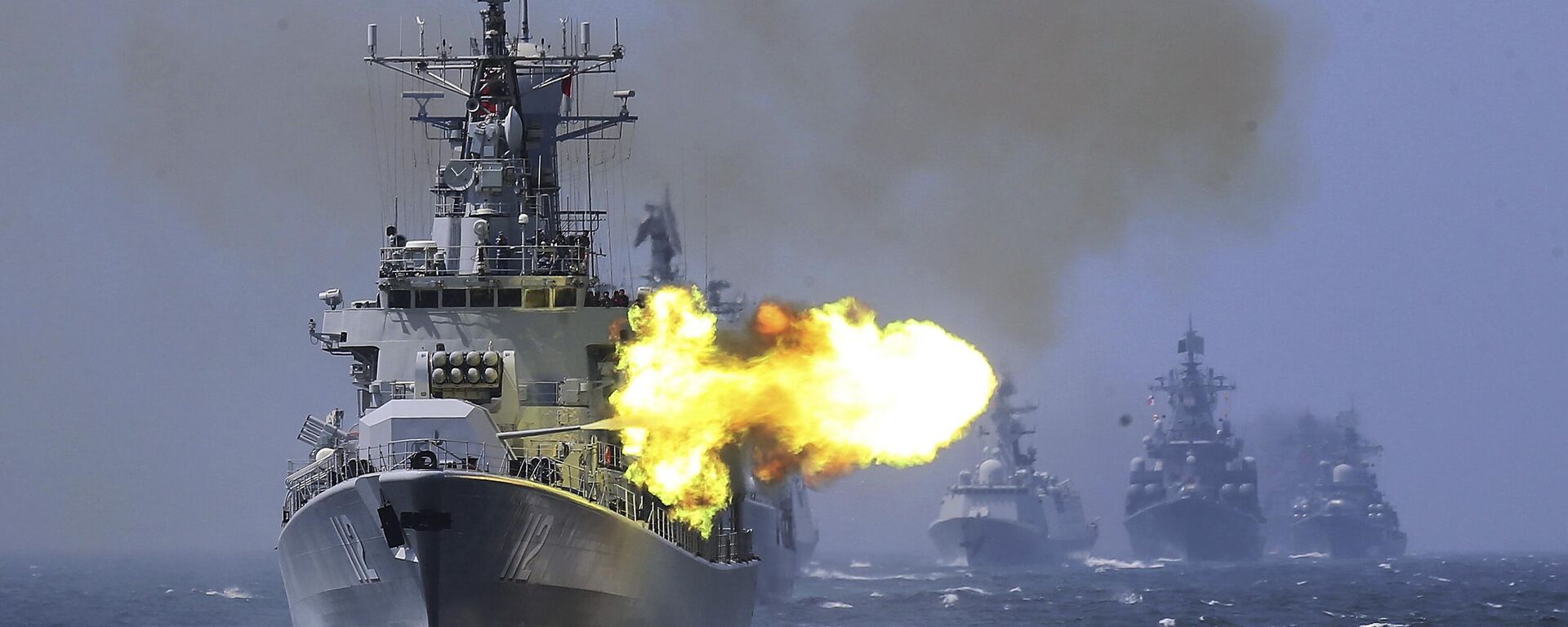https://sputnikglobe.com/20240623/nuke-upgraded-old-b-52s-would-be-a-late-to-the-party-suicide-drill--ex-dod-analyst-1119070056.html
‘Late-to-the-Party Suicide Drill’: Ex-DoD Analyst Derides Bid to Upgrade Outdated B-52s With Nukes
‘Late-to-the-Party Suicide Drill’: Ex-DoD Analyst Derides Bid to Upgrade Outdated B-52s With Nukes
Sputnik International
Restoring nuclear weapon capabilities of the B-52s is largely a political statement, and such bombers would be a late-to-the-party nuclear suicide drill,” Karen Kwiatkowski told Sputnik.
2024-06-23T06:24+0000
2024-06-23T06:24+0000
2024-06-23T07:34+0000
analysis
karen kwiatkowski
us
nuclear triad
b-52 bombers
us congress
pentagon
hypersonic missiles
boeing
https://cdn1.img.sputnikglobe.com/img/07e8/06/17/1119069040_0:69:2000:1194_1920x0_80_0_0_6b125728ebcc3de2195476b8dba929b8.jpg
Congress’ bid to restore the B-52 bombers’ nuclear capabilities comes in the wake of repeated disappointments in developing US hypersonic standoff weapons, retired US Air Force Lt. Col. Karen Kwiatkowski told Sputnik.“It is important to note that Congress and the Pentagon have already approved and funded engine, avionics and radar upgrades for the nearly 60-year-old B-52 airframe. The B-52H models will be designated B-52J's, upon upgrade. This was justified several years ago with the B-52Js as a delivery mechanism for planned AGR-183 hypersonic missiles - a missile tested by the Air Force, but one that is no longer being funded in the FY2025 defense budget,” she underscored.Dozens of the Pentagon’s hypersonic missile projects for the Army, Air Force, Navy, and DARPA have suffered setbacks, despite a desperate race to catch up with Russia and China in this field.It's really all about the Congressional lobbyists, the ex-DoD analyst pointed out, clarifying that in the House, “Congressman Mike Rogers is the second-highest recipient of defense lobby money; In the Senate, Deb Fischer's top donor is Northrup-Grumman a major missile developer, and Boeing, the maker of the B-52, is her fourth-largest donor.”The conventional B-52H Stratofortress bombers had been part of the US nuclear triad close to a decade ago. However, under the New START treaty with Russia, the planes were stripped of these capabilities. With the treaty set to expire in February 2026, there is a drive to “beef up the US nuclear arsenal”. Congress has been advocating making the old bombers nuclear capable again, but the idea does not appear to be viewed favorably in the Pentagon.“The treaty expires in 2026, and... We need to be prepared to face a nuclear environment without any treaty limitations,” said House Armed Services Chairman Mike Rogers, R-Ala., as he introduced the amendment to the passed FY25 defense policy legislation. In line with that bill, the Air Force would start upgrading the bombers within a month after the accord expires. Accordingly, it is hoped that the restoration of the B-52’s nuclear capabilities might be completed by 2029.Democrat Congressman Adam Smith of the Armed Services Committee had voiced opposition, and was cited as saying:“The Department of Defense is not interested in doing this… What they’re interested in doing is investing in the B-21, which is the next generation nuclear-capable bomber. This would cost a great deal of money. Also, they’re currently trying to extend the life of a number of B-52s out to 2050, which they think they can do. This would be another added expense to that.”The Senate Armed Services Committee also voted to advance its version of the bill on restoration of nuclear capabilities of the fleet of bombers dating back to the 1960s.Kwiatkowski dissected the features of the B-52 bomber that originally made it a suitable aircraft for nuclear warheads' deployment during the Cold War, singling out such aspects as “manned crews, ability to fly long distances, with refueling carried out in safe airspace.”These aspects, as well as the “relatively long lead time from launch of aircraft to actual release of nuclear weapons allowed time for recall, and the application of better intelligence and diplomacy,” she said, adding:Moscow added that it would continue to comply with quantitative restrictions on strategic offensive arms and exchange notifications with Washington about ballistic missile launches. In June, the US announced its "countermeasures" in response to Russia’s suspension of the treaty. Both sides say they continue to abide by New START's numerical limits. Karen Kwiatkowski stated that it is clear why the Department of Defense is against the proposition of upgrading the outdated bomber aircraft fleet. She indicated that the DoD recognizes the vulnerabilities and the high cost associated with such a project.She lamented the fact that there are currently "no statesmen in the West interested in preventing nuclear war, as we had during the Cold War.” No matter how much the range the B-52 is upgraded, these outdated planes will never be able to “fully capitalize on the current advances in technology and stealth,” remarked the expert.“Pentagon thinking has one foot in the past (a triad that includes bombers because we have always done it that way) and one foot in the future - irreversible attacks and hostage-holding strategies via high-speed, radar-evading missiles and other weapons launched from land, sea and space. This straddling of past and future delivers the B-21 [Raider aircraft] - a platform that is profitable for manufacturers but unlikely to truly function as planned in coming decades. But that is where US defense path dependency has brought us,” Kwiatkowski pointed out.On a personal note, the former DoD analyst suggested it would be both “cheaper and wiser” to upgrade the B-52 with its human pilots than the B-21 Raider, which is “little more than another unmanned stealth missile.” After all, she summed up, such a platform would not provide any “additional ability, stability or political motivation for political leaders to approach an actual nuclear war cautiously and wisely” in the multipolar world.
https://sputnikglobe.com/20240213/b-52-bomber-overhaul-economically-viable-given-cost-of-developing-new-aircraft-1116761936.html
https://sputnikglobe.com/20240522/dubious-eagle-why-has-pentagon-pumped-756-mln-into-hypersonic-missile-that-doesnt-fly-1118583903.html
https://sputnikglobe.com/20240614/putin-suggests-creation-of-new-security-system-in-eurasia-1118949232.html
Sputnik International
feedback@sputniknews.com
+74956456601
MIA „Rossiya Segodnya“
2024
News
en_EN
Sputnik International
feedback@sputniknews.com
+74956456601
MIA „Rossiya Segodnya“
Sputnik International
feedback@sputniknews.com
+74956456601
MIA „Rossiya Segodnya“
us b-52 stratofortress bomber, what is the us b-52 stratofortress bomber, how is the us b-52 stratofortress bomber to be modernized, why is the us b-52 stratofortress bomber to be modernized for the nuclear triade, why does us want to restore nuclear weapon capabilities on b-52h stratofortress bombers, how practical is it to restore nuclear weapon capabilities on b-52h stratofortress bombers, upgrades for b-52, what are the congress approved and funded uogrades for the b-52, b-52j as a delivery mechanism for planned agr-183 hypersonic missile
us b-52 stratofortress bomber, what is the us b-52 stratofortress bomber, how is the us b-52 stratofortress bomber to be modernized, why is the us b-52 stratofortress bomber to be modernized for the nuclear triade, why does us want to restore nuclear weapon capabilities on b-52h stratofortress bombers, how practical is it to restore nuclear weapon capabilities on b-52h stratofortress bombers, upgrades for b-52, what are the congress approved and funded uogrades for the b-52, b-52j as a delivery mechanism for planned agr-183 hypersonic missile
‘Late-to-the-Party Suicide Drill’: Ex-DoD Analyst Derides Bid to Upgrade Outdated B-52s With Nukes
06:24 GMT 23.06.2024 (Updated: 07:34 GMT 23.06.2024) The defense policy bills for fiscal year 2025 in both the US Senate and House include funding to enhance the nuclear weapon capabilities of approximately 30 B-52H Stratofortress bombers. However, the Pentagon is not enthusiastic about the proposal and instead favors a more expensive option of investing in a next-generation nuclear-capable bomber.
Congress’ bid to restore the B-52 bombers’ nuclear capabilities comes in the wake of repeated
disappointments in developing US hypersonic standoff weapons, retired US Air Force Lt. Col.
Karen Kwiatkowski told Sputnik.
“Putting nukes back on the upgraded B-52 is a band aid that covers that,’ said the former analyst for the US Department of Defense.
“It is important to note that Congress and the Pentagon have already approved and funded engine, avionics and radar upgrades for the nearly 60-year-old B-52 airframe. The B-52H models will be designated B-52J's, upon upgrade. This was justified several years ago with the B-52Js as a delivery mechanism for planned AGR-183 hypersonic missiles - a missile tested by the Air Force, but one that is no longer being funded in the FY2025 defense budget,” she underscored.
Dozens of the Pentagon’s hypersonic missile projects for the Army, Air Force, Navy, and DARPA have suffered setbacks, despite a desperate race
to catch up with Russia and China in this field.
The hypersonic weapon that was in development by the Pentagon, the Air-Launched Rapid Response Weapon (ARRW), had been mired in delays and test failures. The weapon was to be fired from beneath the wing of a B-52 Stratofortress bomber and also contain a glide vehicle. The ARRW program, launched in April 2018, was to achieve operational deployment in 2022. However, in November 2023, after conducting two test flights in August and October 2023, the Fiscal Year 2025 budget provided no funding for procurement or further research and development of the AGM-183, effectively ending the project.
“The initiative will be costly and profitable for the defense industry, and in practical terms it keeps the B-52 in the game for tax-payer dollars. It is somewhat practical, as nuclear re-arming of the new B-52J model, as it completes other B-52 upgrades, fits well in the Boeing and Northrup Grumman industrial base,” noted Kwiatkowski.
It's really all about the Congressional lobbyists, the ex-DoD analyst pointed out, clarifying that in the House, “Congressman Mike Rogers is the second-highest recipient of defense lobby money; In the Senate, Deb Fischer's top donor is Northrup-Grumman a major missile developer, and Boeing, the maker of the B-52, is her fourth-largest donor.”
The conventional B-52H Stratofortress bombers had been part of the US nuclear triad close to a decade ago. However, under the New START treaty with Russia, the planes were stripped of these capabilities. With the treaty set to expire in February 2026, there is a drive to “beef up the US nuclear arsenal”. Congress has been advocating making the old bombers nuclear capable again, but the idea does not appear to be viewed favorably in the Pentagon.
“The treaty expires in 2026, and... We need to be prepared to face a nuclear environment without any treaty limitations,” said House Armed Services Chairman Mike Rogers, R-Ala., as he introduced the amendment to the passed FY25 defense policy legislation. In line with that bill, the Air Force would start upgrading the bombers within a month after the accord expires. Accordingly, it is hoped that the restoration of the B-52’s nuclear capabilities might be completed by 2029.
Democrat Congressman Adam Smith of the Armed Services Committee had voiced opposition, and was cited as saying:
“The Department of Defense is not interested in doing this… What they’re interested in doing is investing in the B-21, which is the next generation nuclear-capable bomber. This would cost a great deal of money. Also, they’re currently trying to extend the life of a number of B-52s out to 2050, which they think they can do. This would be another added expense to that.”
The Senate Armed Services Committee also voted to advance its version of the bill on restoration of nuclear capabilities of the fleet of bombers dating back to the 1960s.

13 February 2024, 17:51 GMT
Kwiatkowski dissected the features of the
B-52 bomber that originally made it a suitable aircraft for nuclear warheads' deployment during the Cold War, singling out such aspects as “
manned crews, ability to fly long distances, with refueling carried out in safe airspace.”
These aspects, as well as the “relatively long lead time from launch of aircraft to actual release of nuclear weapons allowed time for recall, and the application of better intelligence and diplomacy,” she said, adding:
“Today, the push is for unmanned or smaller crews to fly the upgraded B-52 (reducing the need for human decision-making and debate once launched), and today, no airframe that flies as slow and ‘unstealthy’ as the B-52 would be safe after take-off and in flight, given intelligence and defensive capabilities of the target countries and their allies.”
The New Strategic Arms Reduction Treaty entered into force in 2011. Ten years later, Russia and the US negotiated an extension until February 2026. Amid NATO's proxy war in Ukraine, Moscow suspended its participation in the accord on February 21, 2023.
At the time, President Vladimir Putin during his February 2023 speech to the Federal Assembly referenced everything from Washington's unilateral withdrawals from milestone strategic weapons treaties, to NATO's enlargement towards Russia's borders in violation of previous verbal agreements.
Moscow added that it would continue to comply with quantitative restrictions on strategic offensive arms and exchange notifications with Washington about ballistic missile launches. In June, the US
announced its "countermeasures" in response to Russia’s suspension of the treaty. Both sides say they continue to abide by New START's numerical limits.
Karen Kwiatkowski stated that it is clear why the Department of Defense is against the proposition of upgrading the outdated bomber aircraft fleet. She indicated that the DoD recognizes the vulnerabilities and the high cost associated with such a project.
“Upgrading the B-52 is largely a political statement rather than a serious "pillar" in the old concept of US nuclear triad. Nuclear armed B-52s, instead of serving as a signal to an enemy that nuclear war can be prevented even after launch as it was throughout the Cold War, today would simply be a late-to-the-party nuclear suicide drill,” remarked the retired US Air Force officer.
She lamented the fact that there are currently "no statesmen in the West interested in preventing nuclear war, as we had during the Cold War.” No matter how much the range the B-52 is upgraded, these outdated planes will never be able to “fully capitalize on the current advances in technology and stealth,” remarked the expert.
“Pentagon thinking has one foot in the past (a triad that includes bombers because we have always done it that way) and one foot in the future - irreversible attacks and hostage-holding strategies via high-speed, radar-evading missiles and other weapons launched from land, sea and space. This straddling of past and future delivers the B-21 [Raider aircraft] - a platform that is profitable for manufacturers but unlikely to truly function as planned in coming decades. But that is where US defense path dependency has brought us,” Kwiatkowski pointed out.
On a personal note, the former DoD analyst suggested it would be both
“cheaper and wiser” to upgrade the B-52 with its human pilots than the B-21 Raider, which is “
little more than another unmanned stealth missile.” After all, she summed up, such a platform would not provide any “
additional ability, stability or political motivation for political leaders to approach an actual nuclear war cautiously and wisely” in the
multipolar world.“If war is politics by other means, a manned nuclear weapon that can be aborted mid-flight is better than an AI-driven nuclear event that politicians will later claim "wasn't their fault" or was "hacked," said Kwiatkowski.





